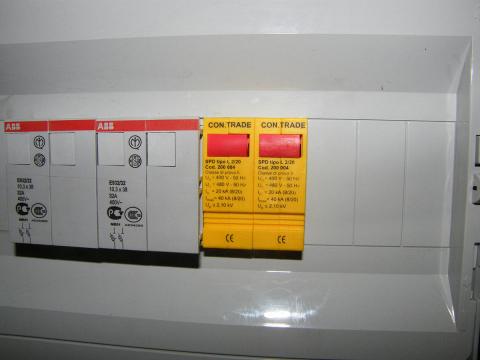
Blog 5: Surge protection
Surge Protection Devices (SPD’s) and what are they?
You may have seen extension leads with built in surge protection. The idea is to plug your sensitive electronic equipment into these and then they are protected from a sudden spike in increased voltage. The spike is ‘arrested’ by the SPD before it can make its way into your precious equipment.
The typical one being installed domestically is a type 2 model. These do not protect against direct lighting strikes (that’s a type 1), but rather harmful voltages entering the property through conductive paths (supply cables, phone lines etc).
Although these have been around for some time, they are now becoming more mandatory in places to have them installed. But how does this affect you, the homeowner? Do you require one?
The most recent updated version of the regulations (BS7671:2018), has introduced a new section completely covering where these need to be used and in typical BS7671 ways, the way this section is written is very confusing and it can be interpreted many different ways.
Its required in a lot of commercial and industrial situations hands down, no question about it, its black and white. But when it comes to domestic situations it’s a lot different.
It states it is required in domestic premises (in a way); however, the electrician can perform a mathematical calculation to see whether it is actually needed, and if it isn’t, then there is no requirement to put it in. I’m not even going to go into the formulae given to do this calculation because its one of the most stupid things I have ever seen and 99.9% of the time, its impossible to carry the calculation out with any form of accuracy, resulting in a lot of guessing.
It doesn’t stop there… It then states that its not required in a single dwelling where the owner of the property feels that the cost of the SPD exceeds the value of the equipment installed inside the home. An SPD ranges from £65 - £100 at the top of my head, anyone is going to have a total sum exceeding this when it comes to the total value of all their equipment.
I have seen some electricians says that this means they are compulsory hands down. I have also seen some electricians state if the homeowner feels that they are an unnecessary cost due to the chances of them getting hit with a spike being slim.
What do I think? I think its better to have one installed than not, however, if I myself was going to put one in (which I haven’t bothered in my place), I would make sure that its easily replaced (most models are) and that it has a visual indicator to say when its lifespan is over. Once these have arrested a surge once, they will need to be replaced as the chances are they will not work again.
I’ll leave you with some answers to some questions that I would answer if I were asked them. This is my personal opinion.
Would you go out of your way to have one retrofitted into you existing set up? No
Would you have one installed if you were having a consumer unit upgrade? Yes
If you were a landlord, would you have one fitted to your rented accommodation? Yes, if a property is hit resulting in your tenants equipment getting fried and it was proven that there were measures you could have taken to prevent it, chances are your going to find yourself liable
Do you think their worth the extra cost? Its always better to ‘have and not need’ than ‘need and have not’. While you may think your property getting hit by a surge is extremely unlikely, I have seen a property local to me hit with a power surge, resulting in loss of electrical equipment, so they do happen.
The thing you have to ask yourself as a consumer, is the cost worth it if the worst happens?

